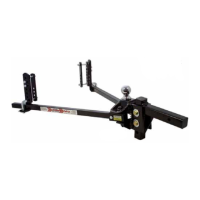26
www.equalizerhitch.com
Trailer is Too Low
or Too High in
Front (More than
1-1/2” from level)
Improper hitch ball
height
Follow Step 7 - Trailer Angle
Adjustment section to change
ball height.
Improper hitch ball
height because shank is
too short
Consult your local Equal-i-zer
hitch dealer about using a spe-
cialty length shank.
Bent or broken L-
bracket, L-pin, or
Link Plate
Link plates installed too
far back from hitch ball
center
Follow Step 4 and set center
of link plates between 29”-32”
from the center of the coupler.
“Walking” Sway
Bracket Assembly
Link plates under-tight-
ened
Follow Step 4 to tighten link
plates correctly.
Link plates over-tight-
ened and bowed
Follow Step 4 to tighten link
plates correctly. If link plate is
excessively bent it should be
replaced.
Noise:
In some cases the friction on the L-brackets or sockets also generates
noise. This most commonly occurs during slow, tight turns where the tow
vehicle and trailer are in a twist. This noise is normal and should be ex-
pected. It is an indication that there is friction on the L-bracket and sockets.
Most of the noise will usually subside after a few uses as the hitch breaks in.
Trailer and tow vehicle loading may also inuence hitch noise.
Lubricating the socket joint may help reduce this noise, and is part of
the required regular maintenance routine. Lubricating the L-bracket joint is
optional. A better solution is a set of ofcial Equal-i-zer brand Sway Bracket
Jackets. They quiet the ride without the mess of using a lubricant.

